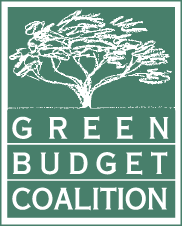In the last few years, Canada has made increasingly ambitious global commitments and important budget and policy actions on climate mitigation, leading to the suite of actions included in the 2022 emissions reduction plan (ERP). Budget 2023 signaled a turning point for climate action and funding, notably in the clean electricity sector.
While these recent efforts to meet the current 2030 GHG emission reduction target of 40-45% below 2005 levels are welcome, the Green Budget Coalition—and many others—considers this target largely insufficient for the country to do its fair share of the global effort to limit global warming to below 1.5°C. As such, leading Canadian environmental NGOs call for actions that lead to 60% emissions reductions below 2005 by 2030 domestically, and more action internationally.
In addition, the quantity and nature of funding solutions still fall short of experts’ recommendations to effectively address the climate crisis and reach the Paris Agreement goals. While the IPCC estimates that around 2.5% of GDP must be invested annually in the energy system to limit warming to 1.5 degrees C, Canadian federal climate mitigation spending only accounts for 0.5% of GDP. According to a recent report from the Canadian Centre for Policy Alternatives, quickly decarbonizing every sector of our economy would require investing 2% of Canada’s GDP over the next five years for a total of $287 million, averaging $57 billion per year in addition to spending planned for the year 2022-2023.
Regarding the nature of solutions to pursue, the IPCC clearly states that net emission reductions in the energy system will come from solar and wind penetration, while fossil carbon capture and storage comes last. In terms of infrastructure, key solutions include more efficient buildings and vehicles, as well as public transit and active transportation.
Effective action in these sectors requires collective action—by all orders of government (federal, provincial, territorial, Indigenous and municipal), industry and businesses, labour, civil society, communities, and individuals. In this context, the federal government has a critical role to play as a key leader to position investments and policy to drive emission reductions, as well as to create market certainty and draw in private investments that will secure a sustainable, net-zero economy that leaves no one behind.
With the United States having adopted its USD $390 billion Inflation Reduction Act, its biggest piece of legislation to combat climate change to date, supported by the Infrastructure Act (USD $1.2 trillion) and the Chips and Science Act (USD $280 billion), Canada needs to shape its own vision for its future economic activities. For more details, see recommendations elsewhere in this document, particularly in the first section, Integrating Climate and Nature Across Government Fiscal Policy, Budgeting, and Spending Decisions, starting with Transforming Canada’s economy through a net-zero industrial policy.
Additionally, with worldwide photovoltaic and electric vehicle deployments that are far ahead of experts’ scenarios in many countries around the world, Canada is lagging behind in developing the infrastructure needed to support these technologies. In short, more money will be needed overall to ensure the full decarbonization of Canada’s economy in a just and timely manner to fulfill its fair share of the global effort and to ensure Canada’s future prosperity.
This document outlines strategically chosen fiscal and budget actions that the Green Budget Coalition sees as the best options to make further progress to reduce emissions over the coming years, providing benefits for the climate and the environment, as well as the economy, and improving equity, human health, affordability and quality of life.
To be successful in its transition, Canada must continue its efforts towards, and take advantage of, low-hanging fruit in the electricity and transportation sectors, as well as plan and lead the phase-out of fossil fuel dependence. Budget 2024 must support further reductions in emissions and continue the important work of building an equitable, carbon-neutral and nature-positive world in alignment with the urgency of the crisis.
For the Green Budget Coalition’s feature recommendations for climate action, please see earlier in this document for:
• A renovation wave for climate resilient homes and affordable home energy;
• Advancing a zero-emissions electricity grid based on renewables; and
• Advancing sustainable jobs for a net-zero Canada.
